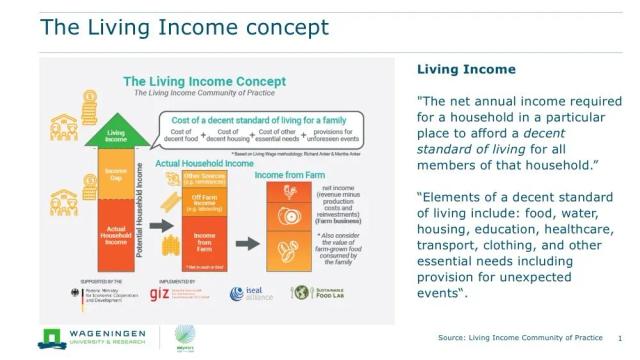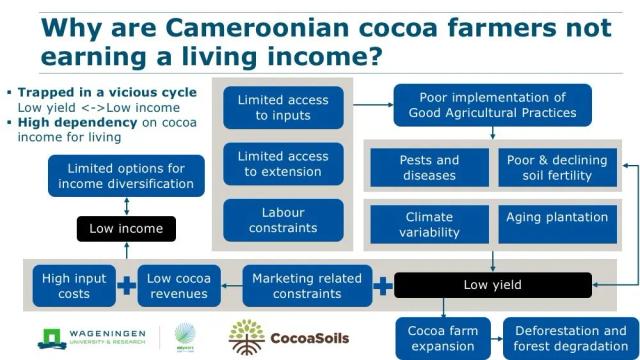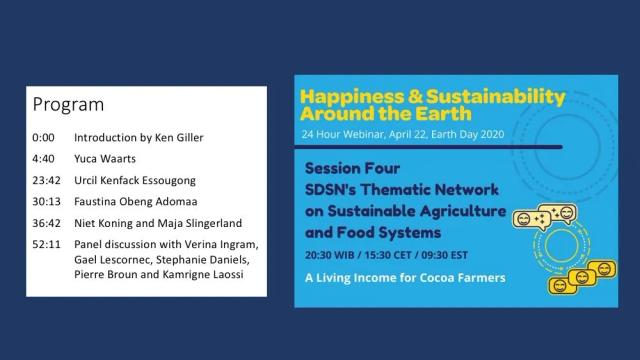Outcomes of A Living Income for Cocoa Farmers
On 22 April, 2020, SDSN Sustainable Agriculture & Food Systems hosted the webinar A Living Income for Cocoa Farmers. This webinar was part of SDSN’s 24-hour webinar celebrating the 50th anniversary of Earth Day by exploring the SDGs through the lens of well-being and happiness.
The webinar was introduced and moderated by Ken Giller, Professor at Wageningen University in the Netherlands and Co-Chair of SDSN Sustainable Agriculture & Food Systems.
The first speaker was Yuca Waarts of Wageningen University, who introduced the concept of living income and familiarized the audience with the cocoa value chain. She showed that a substantial percentage of cocoa farmers live below the poverty line and an even larger percentage below the living income line because farms are small, yields are low, and there are few alternatives. Increasing prices or yields would enable more farmers to earn a living income. However, there are no quick fixes to achieve this because every farmer’s situation is a unique combination of many factors. Therefore, it is important to identify different farmer types and offer them different types of support, either in cocoa farming or outside of cocoa farming (diversifying). Collaboration by the private sector, public sector, NGOs, and the research community is key for this.
Urcil Kenfack Essougong from Cameroon then showed how a vicious cycle of low yields due to limited access to inputs, climate variability, and other factors, together with marketing constraints, high input costs, and low prices, results in low income for farmers. This low income, in turn, limits opportunities for income diversification and opportunities to invest in cocoa farming. Some solutions are improved access to knowledge and technology through farmer fields schools and cooperatives, the introduction of certification schemes, and bringing back the warehousing system, which Niek Koning and Maja Slingerland discussed in more detail.
Faustina Obeng Adomaa from Ghana focused her talk on pruning. Pruning can have many positive effects on yields, but the way in which research and extension promote this to farmers forms a technical, cultural, and political mismatch with farmers’ realities. Therefore, she recommends that better feedback mechanisms among research, extension, and farmers are implemented when new technologies and interventions are being developed. She also recommends that new technologies and interventions move beyond fixed protocols to take into account farmers’ diversity.
Next Maja Slingerland interviewed Niek Koning on the economics and politics of enabling a living income for cocoa farmers. Niek explained that increasing yields and/or prices will lead to overproduction and in turn a price drop. Niek argued that an effective OPEC-type of collaboration for cocoa would contribute to a living income for cocoa farmers. Two important considerations are that most or all cocoa producing countries should be part of it and that benefits have to go to farmers. He also suggesed linking such an initiative to measures against deforestation to make it a 'green OPEC' (have a look at his paperfor more information).
The webinar then continued with a panel discussion between Gael Lescornec (IDH), Pierre Broun (Olam), Kamrigne Laossi (Olam), Stephanie Daniels (Sustainable Food Lab), and Verina Ingram (Wageningen University). The panel focused on actions that the private sector, governments, farmers, NGOs, and researchers could take to enable cocoa farmers to earn a living income. The discussion also focused on what the audience could do to contribute. In addition, questions from the audience on agroforestry, the role of large corporations, and approaches for technology transfer were discussed.
Ken closed the session by concluding that ensuring a living income for cocoa farmers is a topic that concerns us all – farmers, consumers, companies, governments, NGOs, and researchers. Through joint action we make more rapid progress to achieving this goal.



